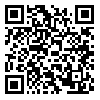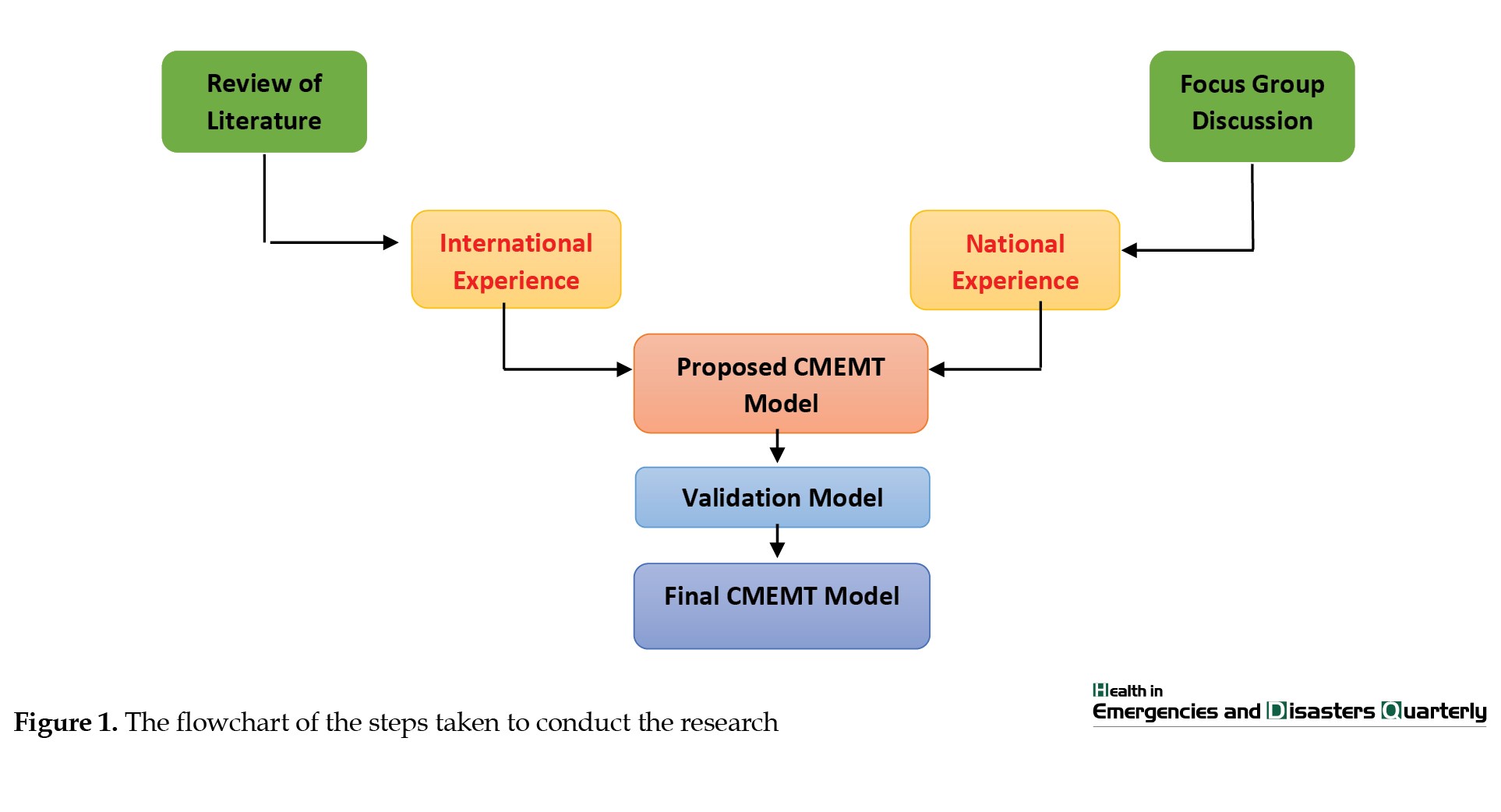Volume 10, Issue 2 (Winter 2025)
Health in Emergencies and Disasters Quarterly 2025, 10(2): 143-152 |
Back to browse issues page
Download citation:
BibTeX | RIS | EndNote | Medlars | ProCite | Reference Manager | RefWorks
Send citation to:



BibTeX | RIS | EndNote | Medlars | ProCite | Reference Manager | RefWorks
Send citation to:
Siddiqi A, Beikzad J, Nejadhaji Ali Irani F, Vedadi A. Designing a Professional Competence Model for Emergency Medical Technicians of the National Emergency Management Organization. Health in Emergencies and Disasters Quarterly 2025; 10 (2) :143-152
URL: http://hdq.uswr.ac.ir/article-1-599-en.html
URL: http://hdq.uswr.ac.ir/article-1-599-en.html
1- Department of Public Administration, Faculty of Humanities, Bonab Branch, Islamic Azad University, Bonab, Iran.
2- Department of Public Administration, Faculty of Humanities, Bonab Branch, Islamic Azad University, Bonab, Iran. ,Beikzad_jafar@yahoo.com
3- Department of Public Administration, Faculty of Humanities, Tehran Branch, Islamic Azad University, Tehran, Iran.
2- Department of Public Administration, Faculty of Humanities, Bonab Branch, Islamic Azad University, Bonab, Iran. ,
3- Department of Public Administration, Faculty of Humanities, Tehran Branch, Islamic Azad University, Tehran, Iran.
Full-Text [PDF 1104 kb]
(765 Downloads)
| Abstract (HTML) (3089 Views)
Full-Text: (583 Views)
Introduction
Pre-hospital emergency medical services (EMS) are essential in reducing mortality [1]. The main goal of EMS is to save lives and reduce disability and death [2]. Emergency medical technicians (EMTs) arrive at the scene during accidents and disasters to immediately provide medical services. This shows the difficulty of their work. They perform a wide range of interventions such as airway management, injury assessment, advanced cardiopulmonary resuscitation (CPR), immobilization of patients, dressing wounds, intravenous therapy, and other advanced procedures [3]. The patients visited by EMTs are usually severely injured or are in bad health conditions and need to be stabilized and transported to the hospital quickly and safely [4]. The mortality rates depend on EMTs’ prompt medical interventions. They have to make critical decisions quickly with little available data and unclear and complicated patient history [5]. Any tool that can help with proper clinical decision-making should be considered in this challenging situation. There are few standardized measures to help EMTs reliably predict the likelihood of patient hospitalization or death based on evidence-based practice. Effective management of resources and the enhancement of treatment outcomes is crucial in this profession [6]. Effective and timely intervention based on clinical information can significantly increase survival rates, especially for patients with heart and brain strokes [7, 8, 9].
Competence is a person’s ability to appropriately manage critical situations and perform a task by applying knowledge and skills [10]. Professional competence refers to a set of knowledge, skills, and attitudes that enable employees to do their jobs according to the protocols [11]. One of the fundamental health needs is to train individuals with specialized scientific and practical abilities and qualifications to help injured people in critical situations [12]. EMTs need to be competent in making critical decisions using available equipment based on patient conditions and other complex aspects of pre-acute care [13]. Therefore, identifying and using the competence criteria in EMS training programs can help the EMTs improve overall patient care [14].
Despite the development of EMS training program.[15], comprehensive research has not been conducted in Iran on the professional competence of EMTs. In some studies on the challenges of EMS personnel in Iran, the lack of knowledge and skills has been reported [16, 17, 18]. In studies conducted in other countries, the dimension of knowledge and skills of EMS personnel, including the ability to perform clinical procedures, has been investigated [19, 20]. In the study by AlShammari et al. in 2019 on the professional competence of EMTs in Saudi Arabia, in addition to knowledge and skills, several dimensions, including familiarity with legal issues, critical thinking, creative thinking, the ability to communicate with patients and other colleagues, stress management, and professional ethics were investigated [21]. Moreover, in a study conducted in Taiwan in 2018 on the qualifications of EMTs, it was concluded that, in addition to knowledge and clinical skills, other skills, including personal growth, report writing, communication skills, critical thinking, and ethical and professional skills, are essential [22]. It is necessary to regularly assess the professional competence of EMS personnel to ensure they can effectively deliver emergency services. In this regard, this research aims to develop a professional competence model for the EMTs of the National Emergency Management Organization (NEMO).
Methods
This is a mixed-method study. The steps depicted in Figure 1 were taken to conduct the study.
Pre-hospital emergency medical services (EMS) are essential in reducing mortality [1]. The main goal of EMS is to save lives and reduce disability and death [2]. Emergency medical technicians (EMTs) arrive at the scene during accidents and disasters to immediately provide medical services. This shows the difficulty of their work. They perform a wide range of interventions such as airway management, injury assessment, advanced cardiopulmonary resuscitation (CPR), immobilization of patients, dressing wounds, intravenous therapy, and other advanced procedures [3]. The patients visited by EMTs are usually severely injured or are in bad health conditions and need to be stabilized and transported to the hospital quickly and safely [4]. The mortality rates depend on EMTs’ prompt medical interventions. They have to make critical decisions quickly with little available data and unclear and complicated patient history [5]. Any tool that can help with proper clinical decision-making should be considered in this challenging situation. There are few standardized measures to help EMTs reliably predict the likelihood of patient hospitalization or death based on evidence-based practice. Effective management of resources and the enhancement of treatment outcomes is crucial in this profession [6]. Effective and timely intervention based on clinical information can significantly increase survival rates, especially for patients with heart and brain strokes [7, 8, 9].
Competence is a person’s ability to appropriately manage critical situations and perform a task by applying knowledge and skills [10]. Professional competence refers to a set of knowledge, skills, and attitudes that enable employees to do their jobs according to the protocols [11]. One of the fundamental health needs is to train individuals with specialized scientific and practical abilities and qualifications to help injured people in critical situations [12]. EMTs need to be competent in making critical decisions using available equipment based on patient conditions and other complex aspects of pre-acute care [13]. Therefore, identifying and using the competence criteria in EMS training programs can help the EMTs improve overall patient care [14].
Despite the development of EMS training program.[15], comprehensive research has not been conducted in Iran on the professional competence of EMTs. In some studies on the challenges of EMS personnel in Iran, the lack of knowledge and skills has been reported [16, 17, 18]. In studies conducted in other countries, the dimension of knowledge and skills of EMS personnel, including the ability to perform clinical procedures, has been investigated [19, 20]. In the study by AlShammari et al. in 2019 on the professional competence of EMTs in Saudi Arabia, in addition to knowledge and skills, several dimensions, including familiarity with legal issues, critical thinking, creative thinking, the ability to communicate with patients and other colleagues, stress management, and professional ethics were investigated [21]. Moreover, in a study conducted in Taiwan in 2018 on the qualifications of EMTs, it was concluded that, in addition to knowledge and clinical skills, other skills, including personal growth, report writing, communication skills, critical thinking, and ethical and professional skills, are essential [22]. It is necessary to regularly assess the professional competence of EMS personnel to ensure they can effectively deliver emergency services. In this regard, this research aims to develop a professional competence model for the EMTs of the National Emergency Management Organization (NEMO).
Methods
This is a mixed-method study. The steps depicted in Figure 1 were taken to conduct the study.
In the first step, after searching in databases such as PubMed, Google Scholar, and Scopus, using the keywords “competency,” “technicians,” “emergency,” and “pre-hospital,” the related articles were extracted and reviewed (Table 1).
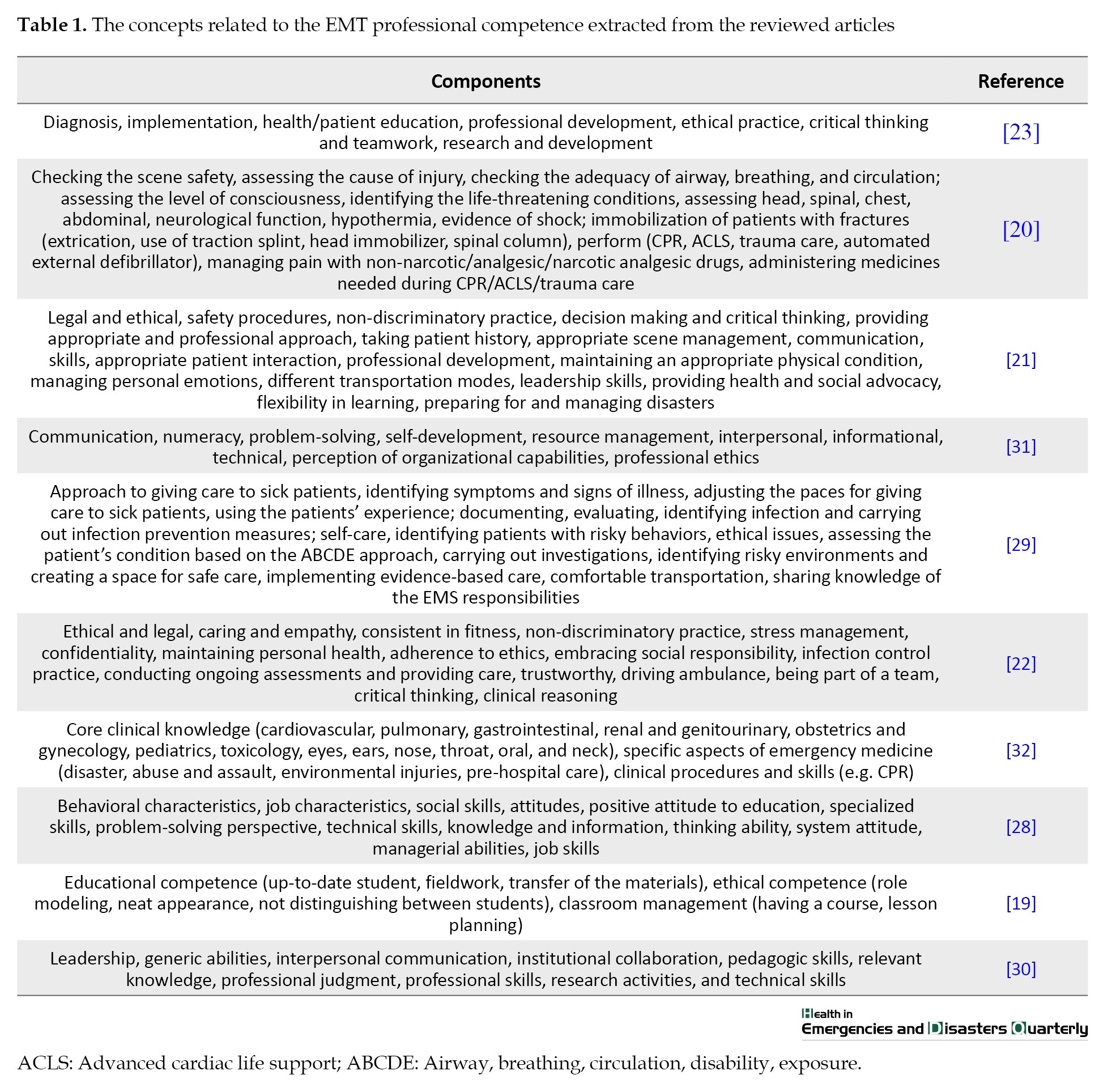
Then, qualitative content analysis was conducted to discover the hidden meanings and find concepts through systematic classification and coding [23, 24]. In the second stage, focus group discussion (FGD) sessions with the presence of 10 experts, including EMS officials and department heads, were held to localize the competence model for EMTs (CMEMT) in Iran. The characteristics of the experts are presented in Table 2.
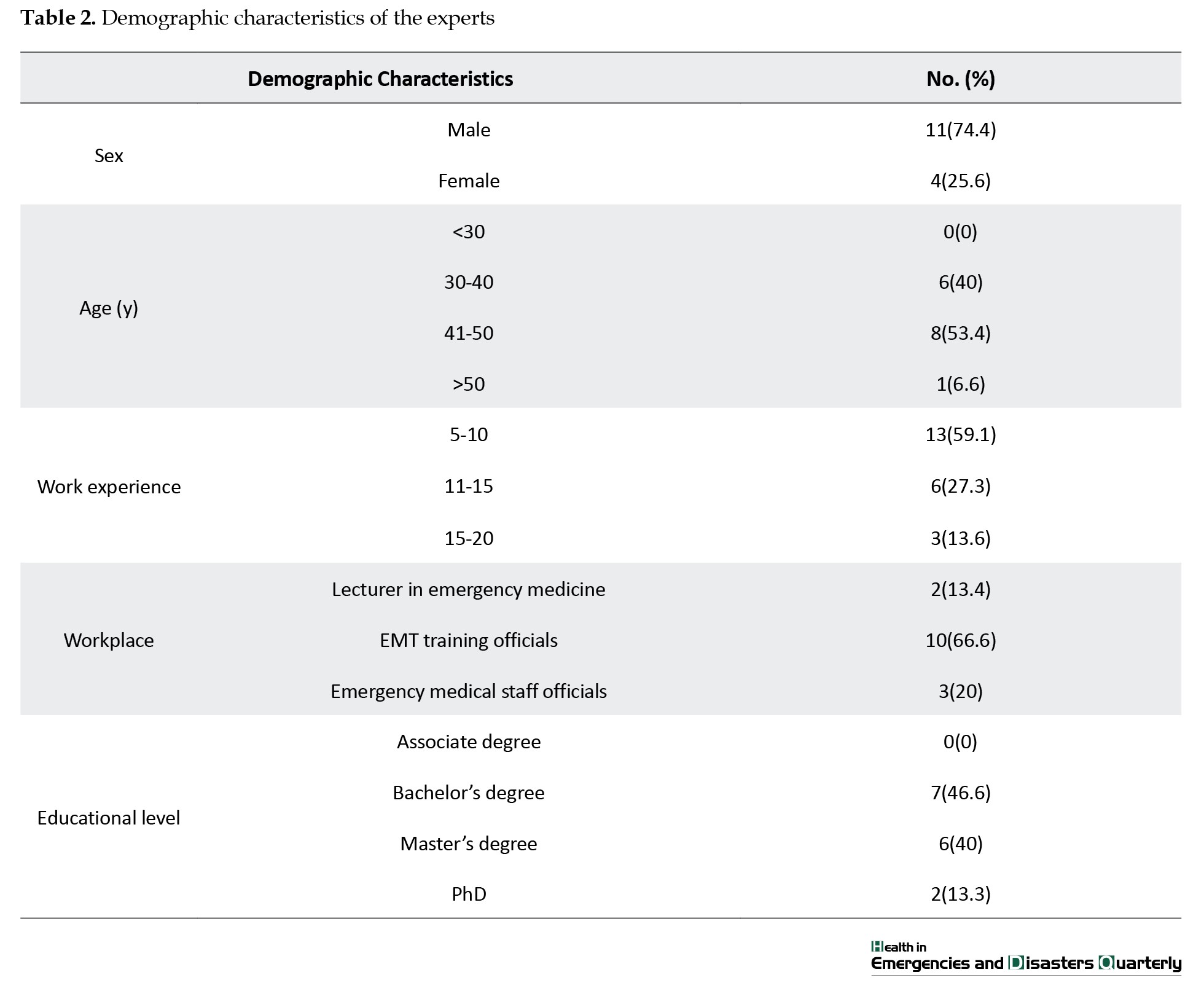
The FGD is a proper method for people involved in the decision-making process and provides them with information about the discussion. The discussion was guided by a trained interviewer (who was the discussion facilitator) [25]. Three rounds of FGDs for five hours and 30 minutes were held from June to July 2023. The experts spent the first 30 minutes of each session on the researchers’ presentation of the results, creating a common understanding of the concepts. This created a common mindset among the researchers and experts. The experts discussed and exchanged opinions on the main themes and sub-themes after the presentation. At the end of the third FGD session, the proposed model was presented, after validation by the experts.
A researcher-made questionnaire containing the identified components was designed. The guidelines were sent to 20 experts, including university professors, managers of the incident management centers in medical universities, and EMT training officials. Of 20, 15 questionnaires were completed and returned. The experts were asked to classify each of the items based on the three-point Likert scale “necessary”, “useful, but not necessary”, and “not necessary”. To measure the content validity ratio (CVR). To measure the content validity index (CVI), the experts were asked to rate the relevance (1=not relevant, 2=relatively relevant, 3=relevant, and 4=completely relevant), simplicity (1=complex, 2=somewhat complex, 3=simple, and 4=completely simple) and clarity (1=not clear, 2=relatively clear, 3=clear, and 4=completely clear) of each item.
The CVR was measured based on the Lawshe method [26] the following formula: CVR=(Ne-N/2)/(N/2), where Ne is the number of experts who answered the “necessary” option, and N is the total number of experts. The minimum acceptable CVR value for 15 experts is about 0.40. Waltz & Bausell’s method was used to measure CVI [27] based on the following formula: CVI=number of experts providing a score of 3 or 4/total number of experts. The minimum acceptable value for the CVI index is 0.79.
Results
Table 3 shows the results of qualitative content analysis and classification of the results for proposing the initial CMEMT, which had five main themes and 18 sub-themes.
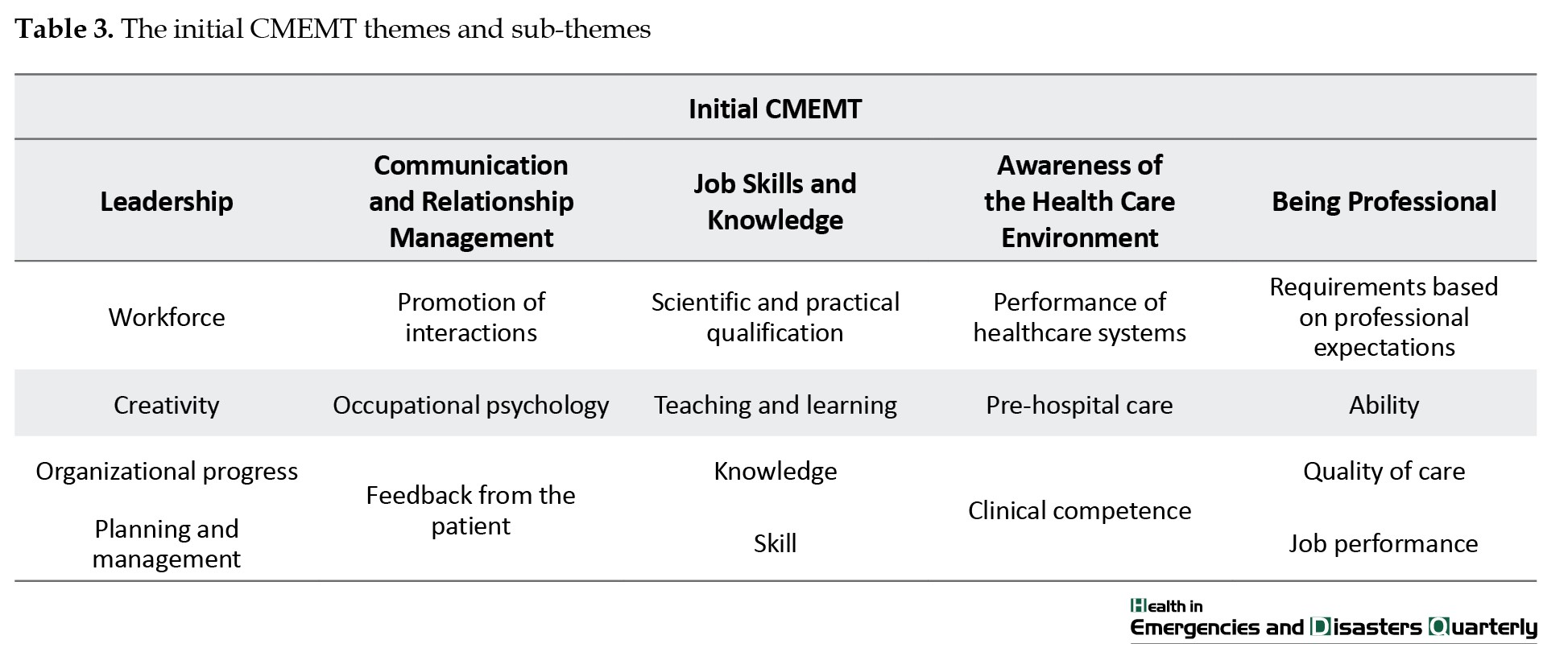
During the FGD sessions, the number of themes remained unchanged, but the number of sub-themes decreased from 18 to 11. The final CMEMT included five main themes (attribute, knowledge, skill, ability, and attitude) and 11 sub-themes (physical health, mental health, professional knowledge, organizational knowledge, clinical skill, technical skill, managerial ability, cognitive ability, professional ability, individual attitude, and organizational attitude). Figure 2 illustrates the final CMEMT.

Then, qualitative content analysis was conducted to discover the hidden meanings and find concepts through systematic classification and coding [23, 24]. In the second stage, focus group discussion (FGD) sessions with the presence of 10 experts, including EMS officials and department heads, were held to localize the competence model for EMTs (CMEMT) in Iran. The characteristics of the experts are presented in Table 2.

The FGD is a proper method for people involved in the decision-making process and provides them with information about the discussion. The discussion was guided by a trained interviewer (who was the discussion facilitator) [25]. Three rounds of FGDs for five hours and 30 minutes were held from June to July 2023. The experts spent the first 30 minutes of each session on the researchers’ presentation of the results, creating a common understanding of the concepts. This created a common mindset among the researchers and experts. The experts discussed and exchanged opinions on the main themes and sub-themes after the presentation. At the end of the third FGD session, the proposed model was presented, after validation by the experts.
A researcher-made questionnaire containing the identified components was designed. The guidelines were sent to 20 experts, including university professors, managers of the incident management centers in medical universities, and EMT training officials. Of 20, 15 questionnaires were completed and returned. The experts were asked to classify each of the items based on the three-point Likert scale “necessary”, “useful, but not necessary”, and “not necessary”. To measure the content validity ratio (CVR). To measure the content validity index (CVI), the experts were asked to rate the relevance (1=not relevant, 2=relatively relevant, 3=relevant, and 4=completely relevant), simplicity (1=complex, 2=somewhat complex, 3=simple, and 4=completely simple) and clarity (1=not clear, 2=relatively clear, 3=clear, and 4=completely clear) of each item.
The CVR was measured based on the Lawshe method [26] the following formula: CVR=(Ne-N/2)/(N/2), where Ne is the number of experts who answered the “necessary” option, and N is the total number of experts. The minimum acceptable CVR value for 15 experts is about 0.40. Waltz & Bausell’s method was used to measure CVI [27] based on the following formula: CVI=number of experts providing a score of 3 or 4/total number of experts. The minimum acceptable value for the CVI index is 0.79.
Results
Table 3 shows the results of qualitative content analysis and classification of the results for proposing the initial CMEMT, which had five main themes and 18 sub-themes.

During the FGD sessions, the number of themes remained unchanged, but the number of sub-themes decreased from 18 to 11. The final CMEMT included five main themes (attribute, knowledge, skill, ability, and attitude) and 11 sub-themes (physical health, mental health, professional knowledge, organizational knowledge, clinical skill, technical skill, managerial ability, cognitive ability, professional ability, individual attitude, and organizational attitude). Figure 2 illustrates the final CMEMT.
Table 4 shows the values of the CVR and CVI for each item of the questionnaire designed based on the CMEMT.
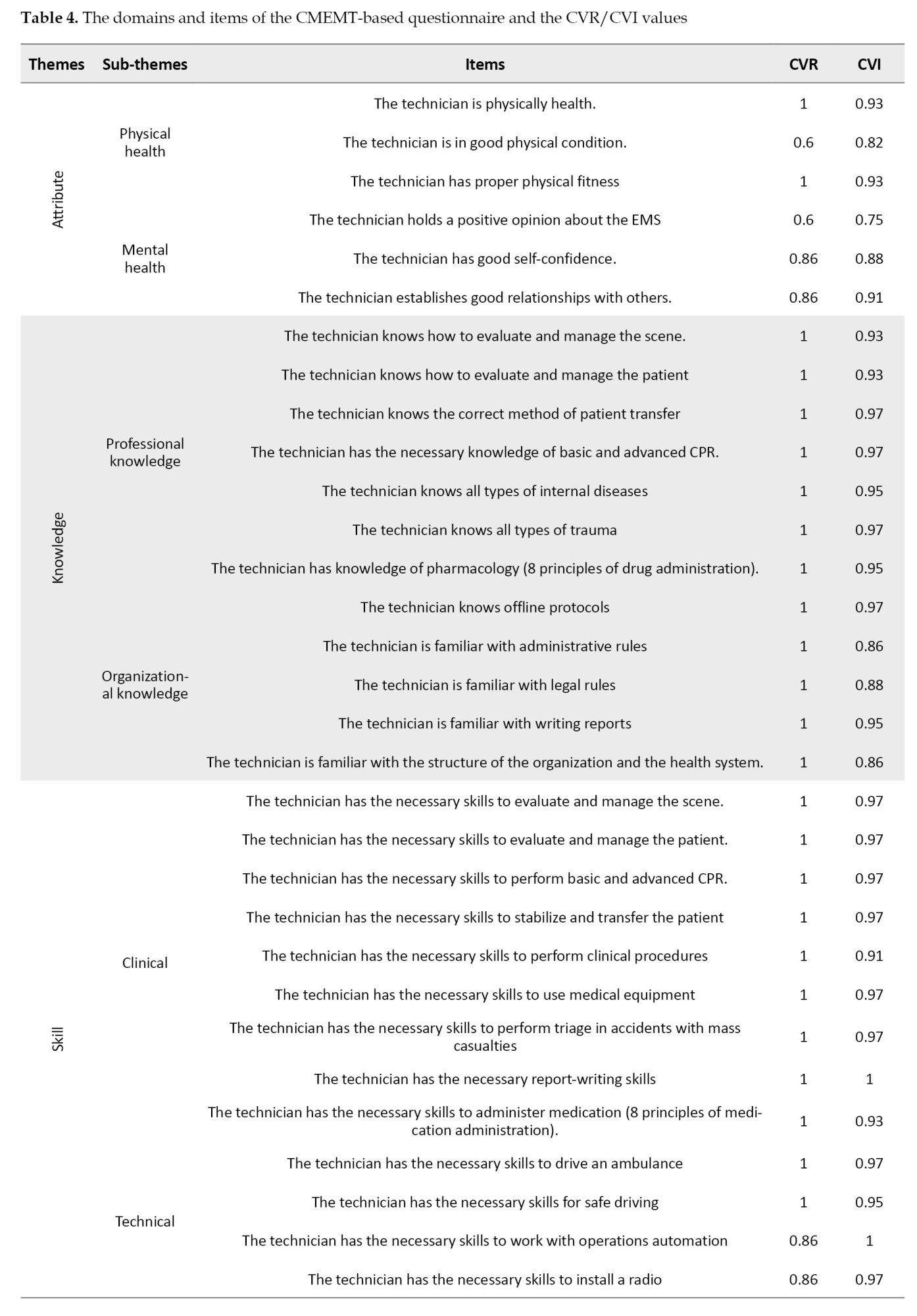
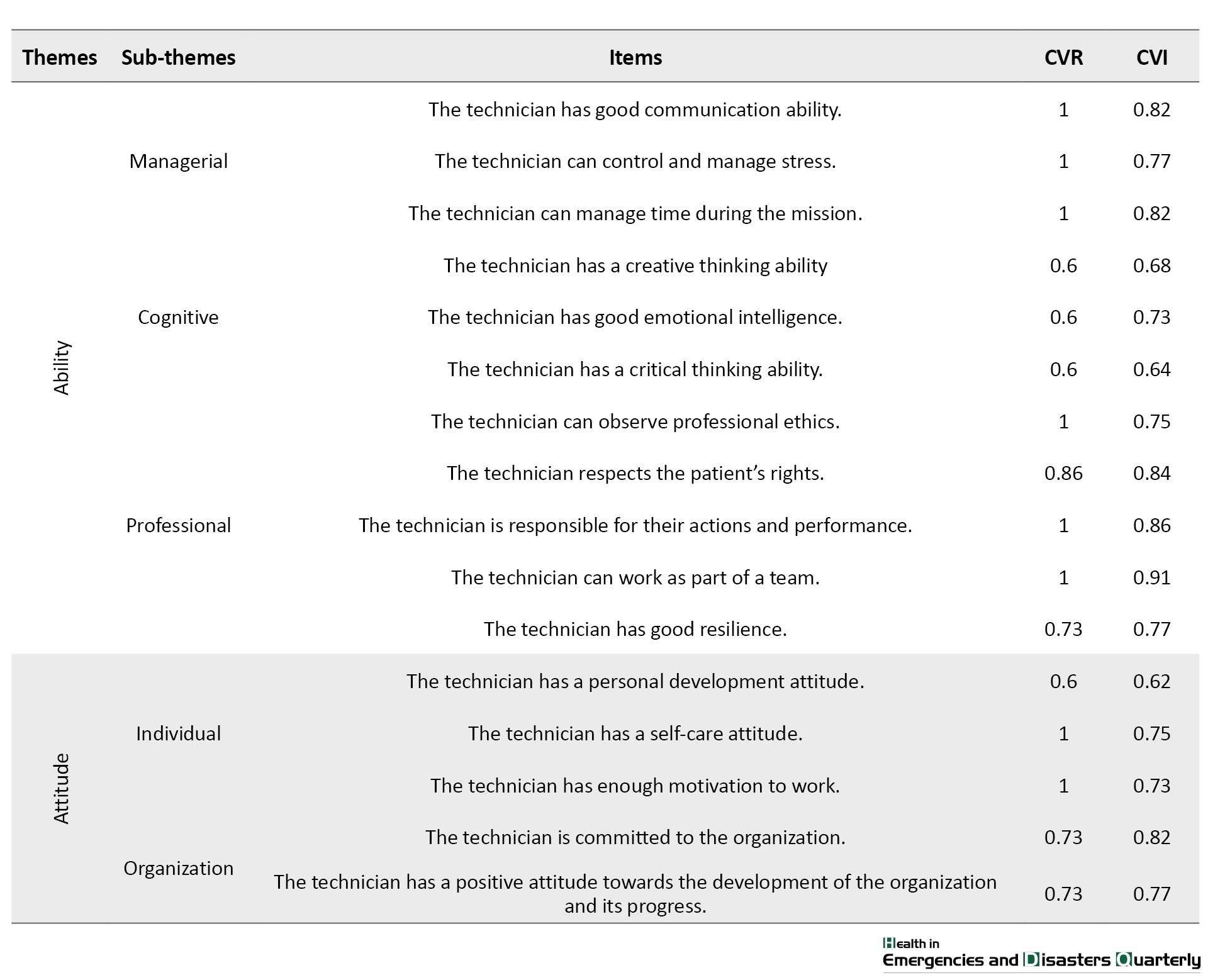
All items were confirmed, and no items were deleted.
Discussion
This research was conducted to design a professional competence model for the NEMO’s EMTs based on national and international experiences. The final model, abbreviated as CMEMT, had five main themes and 11 sub-themes. The professional competence of EMTs included the five themes of attribute, knowledge, skills, ability, and attitude, and its sub-themes included physical health, mental health, professional knowledge, organizational knowledge, clinical skills, technical skills, managerial ability, cognitive ability, professional ability, individual attitude, and organizational attitude. In addition to introducing the essential components for the professional competence of EMTs, the designed model also included the characteristics and attitudes of EMTs.
Attribute was the first theme in the CMEMT. The health characteristics are the basis for the professional competence of EMTs. This theme included two sub-themes of physical and mental health. The physical health sub-theme included three categories of health, proper physical conditions, and physical fitness. The mental health sub-theme included positive thoughts about the EMS profession, self-confidence, and positive relationships with others. Physical and mental health have also been considered in the studies by Poorkarimi et al. [28], Chang et al. [22], and Nilsson et al. [29].
After acquiring the necessary characteristics, the next step is to acquire professional and organizational knowledge. Compliance with the principles, rules, and job requirements within an organization and when engaging in tasks can enhance the quality of EMS. Therefore, upon the arrival of new EMTs, they should familiarize themselves with the standards, principles, and expected performance. There were 12 categories in the knowledge theme, which have also been mentioned in other studies [23, 28, 30]. This theme included knowledge of patient evaluation and management, correct referral of patients, basic and advanced CPR, recognition of internal diseases, recognition of trauma, pharmacology, offline protocols, administrative rules, legal rules, report writing, organization structure, and health system.
In the CMEMT, skill was the next important theme, after knowledge. The EMTs need to have technical skills in addition to clinical skills. Clinical skills included nine categories of scene evaluation and management, patient evaluation and management, basic and advanced CPR, patient immobilization and transfer, clinical procedures, medical equipment use, triage in accidents with mass casualty, report writing, and medication. Technical skills included driving an ambulance, safe driving, working with operations automation, and establishing radio communications. Considering the advancement of technology and medical knowledge, sufficient knowledge and skill in this profession seem necessary.
In the ability theme, the factors affecting the professional competence of EMTs were divided into three sub-themes: Managerial, cognitive, and professional. The managerial sub-theme included communication, stress management, and time management. In the studies by Poorkarimi et al. [28], Chang et al. [23], and Nilsson et al. [29], these abilities have also been mentioned. Time management is a critical factor for EMS personnel. Prioritizing time in emergency situations can help reduce mortality rates. On the other hand, since EMS personnel often face stressful conditions in their workplace, stress management ability is particularly important for them to maintain their physical health and work. Also, considering that they are constantly in contact with injured people, other relief groups, or colleagues, possessing communication ability is of utmost importance. The next sub-theme was cognitive ability, which had three categories: creative thinking, emotional intelligence, and critical thinking. In Al-Shmari et al.’s study [21], this factor was also mentioned and listed as one component of competence in EMTs. The professional sub-theme addresses issues such as respecting the patient’s rights, adhering to professional ethics, demonstrating responsibility and resilience, and fostering teamwork. The studies on the EMS personnel have emphasized the need for improved coordination and teamwork among EMTs [29-32].
In the CMEMS model, attitude was the final theme, which had two sub-themes of individual and organizational. Individual attitude consisted of attitude towards personal growth, self-care, and sufficient work motivation. On the other hand, organizational attitude included a positive attitude towards the development and progress of the organization and having commitment to the organization, which can improve performance and increase the productivity of organizations.
Conclusion
The designed model for the professional competence of the NEMO’s EMTs is a comprehensive and coherent model tailored to international and national standards and can be used in other countries. This model can help EMTs reach their highest qualifications.
Ethical Considerations
Compliance with ethical guidelines
All ethical considerations, such as a clear explanation of the study objectives to experts and obtaining their informed consent, their freedom to leave in the study, and confidentiality of their personal information, were observed. A code of ethics was obtained from Tabriz Branch, the Islamic Azad University (Code: IR.IAU.TABRIZ.REC.1401.218),
Funding
This article was extracted from the PhD dissertation of Amir Sedighi, approved by the Department of Public Administration, Faculty of Humanities, Bonab Branch, Islamic Azad University, Bonab, Iran.
Authors' contributions
All authors equally contributed to preparing this article.
Conflict of interest
The authors declared no conflict of interest.
Acknowledgments
The authors would like to thank the experts who participated in this study for their valuable comments.
References


All items were confirmed, and no items were deleted.
Discussion
This research was conducted to design a professional competence model for the NEMO’s EMTs based on national and international experiences. The final model, abbreviated as CMEMT, had five main themes and 11 sub-themes. The professional competence of EMTs included the five themes of attribute, knowledge, skills, ability, and attitude, and its sub-themes included physical health, mental health, professional knowledge, organizational knowledge, clinical skills, technical skills, managerial ability, cognitive ability, professional ability, individual attitude, and organizational attitude. In addition to introducing the essential components for the professional competence of EMTs, the designed model also included the characteristics and attitudes of EMTs.
Attribute was the first theme in the CMEMT. The health characteristics are the basis for the professional competence of EMTs. This theme included two sub-themes of physical and mental health. The physical health sub-theme included three categories of health, proper physical conditions, and physical fitness. The mental health sub-theme included positive thoughts about the EMS profession, self-confidence, and positive relationships with others. Physical and mental health have also been considered in the studies by Poorkarimi et al. [28], Chang et al. [22], and Nilsson et al. [29].
After acquiring the necessary characteristics, the next step is to acquire professional and organizational knowledge. Compliance with the principles, rules, and job requirements within an organization and when engaging in tasks can enhance the quality of EMS. Therefore, upon the arrival of new EMTs, they should familiarize themselves with the standards, principles, and expected performance. There were 12 categories in the knowledge theme, which have also been mentioned in other studies [23, 28, 30]. This theme included knowledge of patient evaluation and management, correct referral of patients, basic and advanced CPR, recognition of internal diseases, recognition of trauma, pharmacology, offline protocols, administrative rules, legal rules, report writing, organization structure, and health system.
In the CMEMT, skill was the next important theme, after knowledge. The EMTs need to have technical skills in addition to clinical skills. Clinical skills included nine categories of scene evaluation and management, patient evaluation and management, basic and advanced CPR, patient immobilization and transfer, clinical procedures, medical equipment use, triage in accidents with mass casualty, report writing, and medication. Technical skills included driving an ambulance, safe driving, working with operations automation, and establishing radio communications. Considering the advancement of technology and medical knowledge, sufficient knowledge and skill in this profession seem necessary.
In the ability theme, the factors affecting the professional competence of EMTs were divided into three sub-themes: Managerial, cognitive, and professional. The managerial sub-theme included communication, stress management, and time management. In the studies by Poorkarimi et al. [28], Chang et al. [23], and Nilsson et al. [29], these abilities have also been mentioned. Time management is a critical factor for EMS personnel. Prioritizing time in emergency situations can help reduce mortality rates. On the other hand, since EMS personnel often face stressful conditions in their workplace, stress management ability is particularly important for them to maintain their physical health and work. Also, considering that they are constantly in contact with injured people, other relief groups, or colleagues, possessing communication ability is of utmost importance. The next sub-theme was cognitive ability, which had three categories: creative thinking, emotional intelligence, and critical thinking. In Al-Shmari et al.’s study [21], this factor was also mentioned and listed as one component of competence in EMTs. The professional sub-theme addresses issues such as respecting the patient’s rights, adhering to professional ethics, demonstrating responsibility and resilience, and fostering teamwork. The studies on the EMS personnel have emphasized the need for improved coordination and teamwork among EMTs [29-32].
In the CMEMS model, attitude was the final theme, which had two sub-themes of individual and organizational. Individual attitude consisted of attitude towards personal growth, self-care, and sufficient work motivation. On the other hand, organizational attitude included a positive attitude towards the development and progress of the organization and having commitment to the organization, which can improve performance and increase the productivity of organizations.
Conclusion
The designed model for the professional competence of the NEMO’s EMTs is a comprehensive and coherent model tailored to international and national standards and can be used in other countries. This model can help EMTs reach their highest qualifications.
Ethical Considerations
Compliance with ethical guidelines
All ethical considerations, such as a clear explanation of the study objectives to experts and obtaining their informed consent, their freedom to leave in the study, and confidentiality of their personal information, were observed. A code of ethics was obtained from Tabriz Branch, the Islamic Azad University (Code: IR.IAU.TABRIZ.REC.1401.218),
Funding
This article was extracted from the PhD dissertation of Amir Sedighi, approved by the Department of Public Administration, Faculty of Humanities, Bonab Branch, Islamic Azad University, Bonab, Iran.
Authors' contributions
All authors equally contributed to preparing this article.
Conflict of interest
The authors declared no conflict of interest.
Acknowledgments
The authors would like to thank the experts who participated in this study for their valuable comments.
References
- Afshari A, Khodaveisi M, Sadeghian E. Exploring the educational challenges in emergency medical students: A qualitative study. Journal of Advances in Medical Education & Professionalism. 2021; 9(2):79-84. [PMID]
- Millin MG, Johnson DE, Schimelpfenig T, Conover K, Sholl M, Busko J, et al. Medical oversight, educational core content, and proposed scopes of practice of wilderness EMS providers: A joint project developed by wilderness EMS educators, medical directors, and regulators using a Delphi approach. Prehospital Emergency Care. 2017; 21(6):673-81. [DOI:10.1080/10903127.2017.1335815] [PMID]
- Aminizadeh M, Farrokhi M, Ebadi A, Masoumi G, Kolivand P, Khankeh H. Hospital preparedness challenges in biological disasters: A qualitative study. Disaster Medicine and Public Health Preparedness. 2022; 16(3):956-60. [DOI:10.1017/dmp.2020.434] [PMID]
- Masterson S, Deasy C, Doyle M, Hennelly D, Knox S, Sorensen J. What clinical crew competencies and qualifications are required for helicopter emergency medical services? A review of the literature. Scandinavian Journal of Trauma, Resuscitation and Emergency Medicine. 2020; 28(1):28. [DOI:10.1186/s13049-020-00722-z] [PMID]
- Stanley IH, Hom MA, Joiner TE. A systematic review of suicidal thoughts and behaviors among police officers, firefighters, EMTs, and paramedics. Clinical Psychology Review. 2016; 44:25-44. [DOI:10.1016/j.cpr.2015.12.002] [PMID]
- Crowe RP, Bower JK, Cash RE, Panchal AR, Rodriguez SA, Olivo-Marston SE. Association of burnout with workforce-reducing factors among EMS professionals. Prehospital Emergency Care. 2018; 22(2):229-36. [DOI:10.1080/10903127.2017.1356411] [PMID]
- Jones S. Describing the mental health profile of first responders: A systematic review [Formula: See text]. Journal of The American Psychiatric Nurses Association. 2017; 23(3):200-14.[DOI:10.1177/1078390317695266] [PMID]
- Leblanc VR, Regehr C, Tavares W, Scott AK, Macdonald R, King K. The impact of stress on paramedic performance during simulated critical events. Prehospital and Disaster Medicine. 2012; 27(4):369-74. [DOI:10.1017/S1049023X12001021] [PMID]
- LeBlanc VR, MacDonald RD, McArthur B, King K, Lepine T. Paramedic performance in calculating drug dosages following stressful scenarios in a human patient simulator. Prehospital emergency Care. 2005; 9(4):439-44. [DOI:10.1080/10903120500255255] [PMID]
- Döös, M. Connections at place of work-about learning and competences in relations in daily life. Arbetsmarknad Arbetsliv. 2004; 2:77-92. [Link]
- Azarnejad K. [Effect of professional competence components on agriculture high schools educators’ job performance in the North West Provinces of Iran (Persian)]. Journal of Agricultural Education Administration Research. 2017; 9(41):130-46. [Link]
- Aliakbari F, Aien F, Bahrami M. [Assessment competencies among emergency nurses for responding in disaster situation with Objective Structured Clinical Examination (Persian)]. Journal of Health Promotion Management. 2014; 3(3):47-57. [Link]
- Tavares W, Boet S. On the assessment of paramedic competence: A narrative review with practice implications. Prehospital and Disaster Medicine. 2016; 31(1):64-73. [DOI:10.1017/S1049023X15005166] [PMID]
- Vejdani H, Fatemeh Talebian F, Moradi A, Sanagoo A, Jouybari L. [Explaining nursing students’ understanding of teachers’ professional competence: Qualitative content analysis (Persian)]. Research in Medical Education. 2023; 15(2):26-35. [DOI:10.32592/rmegums.15.2.26]
- Ministry of Health and Medical Education. [Training program for associate degree in emergency medicine (Persian)]. Tehran: Ministry of Health and Medical Education, 2000. [Link]
- Poornazari M, Roshanzadeh M, Mohammadi S, Taj A, Shirvani M, Naghneh MH, et al. Explaining the challenges of pre-hospital emergency healthcare workers in providing care at the scene. Journal of Emergency Medicine, Trauma & Acute Care. 2023; 2023(2):21. [DOI:10.5339/jemtac.2023.21]
- Hadian M, Jabbari A, Abdollahi M, Hosseini E, Sheikhbardsiri H. Explore pre-hospital emergency challenges in the face of the COVID-19 pandemic: A quality content analysis in the Iranian context. Frontiers in Public Health. 2022; 10:864019. [DOI:10.3389/fpubh.2022.864019] [PMID]
- Mohammadi M, Firouzkouhi M, Abdollahimohammad A, Shivanpour M. [The challenges of pre-hospital emergency personnel in Sistan area: A qualitative study (Persian)]. Journal of Qualitative Research in Health Sciences. 2019; 8(3):221-32. [Link]
- Mohd Said N, Sukonthasarn A, Wangsrikhun S, Chanpransit C. Assessing and exploring the competency of prehospital emergency medical service personnel in Klang Valley, Malaysia: A mixed method approach. IIUM Medical Journal Malaysia. 2014; 13(2):7-19. [Link]
- Amirrafiei A, Zia Ziabari SM, Haghshenas-Bakerdar F, Kazemnejad-Leili E, Asadi P. Clinical competencies of emergency medical services paramedics in responding to emergency conditions using objective structured clinical examination (osce) in Guilan. Journal of Emergency Practice and Trauma. 2021; 7(2):101-5. [DOI:10.34172/jept.2021.03]
- AlShammari T, Jennings P, Williams B. Emergency medical services core competencies: A Delphi study. Australasian Journal of Paramedicine. 2019; 16:1-8. [Link]
- Chang YT, Tsai KC, Williams B. Development of new core competencies for Taiwanese Emergency Medical Technicians. Advances in Medical Education and Practice. 2018; 9:147-58. [DOI:10.2147/AMEP.S153403] [PMID]
- Çalışkan F, Şenyuva E. A valid and reliable tool to assess nursing professional competences: The Nursing Professional Competence Scale. Medical Journal of Bakirkoy. 2022; 18(2):177-88. [DOI:10.4274/BMJ.galenos.2021.2021.11-2]
- Graneheim UH, Lindgren BM, Lundman B. Methodological challenges in qualitative content analysis: A discussion paper. Nurse Education Today. 2017; 56:29-34. [DOI:10.1016/j.nedt.2017.06.002] [PMID]
- Gronkjaer M, Curtis T, de Crespigny C, Delmar C.Analysing group interaction in focus group research:Impact on content and the role of the moderator.Qualitative Studies. 2011; 2(1):16-30. [DOI:10.7146/qs.v2i1.4273]
- Lawshe CH. A quantitative approach to content validity. Personnel Psychology. 1975; 28(4):563-75. [DOI:10.1111/j.1744-6570.1975.tb01393.x]
- Waltz CF, Bausell RB. Nursing Research: Design. Statistics, and Computer Analysis:FA Davis Company; 1981.
- Poorkarimi J, Keramati MR, Mohammadi AR. [Identifying and determining professional competencies of human resources experts (Persian)]. Management Studies in Development and Evolution. 2017; 26(86):61-96. [DOI:10.22054/jmsd.2017.8443]
- Nilsson J, Johansson S, Nordström G, Wilde-Larsson B. Development and validation of the ambulance nurse competence scale. Journal of Emergency Nursing. 2020; 46(1):34-43. [DOI:10.1016/j.jen.2019.07.019] [PMID]
- Wihlborg J, Edgren G, Johansson A, Sivberg B. The desired competence of the Swedish ambulance nurse according to the professionals-a Delphi study. International Emergency Nursing. 2014; 22(3):127-33. [DOI:10.1016/j.ienj.2013.10.004] [PMID]
- Hong SG. Defining core competencies for 119 emergency medical technicians based on the analysis of requirements and priorities of the profession. The Korean Journal of Emergency Medical Services. 2019; 23(2):7-18. [DOI:10.14408/KJEMS.2019.23.2.007]
- Kim SC, Ro YS, Shin SD, Wi DH, Jeong J, Park JO, et al. Assessment of competence in emergency medicine among healthcare professionals in Cameroon. Journal of Korean Medical Science. 2017; 32(12):1931-7. [DOI:10.3346/jkms.2017.32.12.1931] [PMID]
Type of article: Research |
Subject:
Emergency
Received: 2024/01/12 | Accepted: 2024/07/7 | Published: 2025/01/1
Received: 2024/01/12 | Accepted: 2024/07/7 | Published: 2025/01/1
Send email to the article author
| Rights and permissions | |
 |
This work is licensed under a Creative Commons Attribution-NonCommercial 4.0 International License. |


